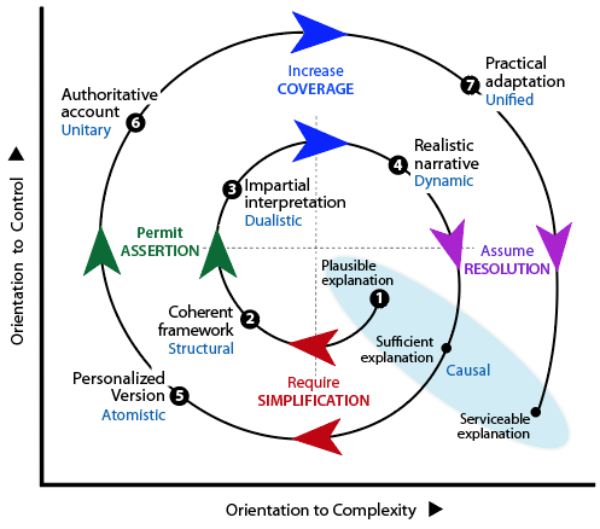Patterns within Increasing Clarity
Diamonds of Adaptation & Regulation
There appears to be an oscillating pattern generally found in Spirals that defines, or at least relates to, the oscillating duality of the Spiral-derived Tree. It was originally developed in managing work complexity (PH'5Q2C) and in making political choices (PH'6C); and then subsequently applied to the sense of self (PH'4C), and strengthening coping (RH'C).
Using the to clarify how clarification works, this Spiral should conform to the same pattern, so providing further clarification and confirmation of the analysis. Simple observation reveals that it does.
«Accept-and-adapt» applies to the odd levels, and «determine-and-develop »applies to the even levels and the end-point of the Spiral.
The diagram of interlocking diamonds is shown below.

This diamonds proposition accords with the oscillating duality developed during the investigation: «determine and develop» fits with "objective-comprehensive" modes and «accept and adapt» fits with the "subjective-limited" modes. But there is an additional twist created by the cumulation of principles: the commences the trajectory as subjective and limited, but ends the trajectory as objective and comprehensive.
Transition Pairs
The Spiral reveals 4 patterns of movement relevant to the axes.
The initial transition in each Cycle, and , is back along the X-axis towards lesser concern for complexity that leads to a useful requirement for simplification: in Cycle-1 for the analysis, and in Cycle-2 for the person.
The next transition in each Cycle, and , is up the Y-axis towards more concern for control. This is associated with permission for greater assertion: in Cycle-1 for exposing polarization, and in Cycle-2 for standards applicable to the explanation.
The third transition in each Cycle, and , is forward along the X-axis towards more concern for complexity. This allows for greater coverage of details of the situation in Cycle-1, and of different contexts that may apply in Cycle-2.
The final transition in each Cycle is down the Y-axis back to with less concern for control. Because control has already been established, the transition is spontaneous and issues are assumed resolved: in Cycle-1 the resolution relates to the explanation, and in Cycle-2 in regard to a willingness to accept it.

-
Back to Review.
Originally posted: 30-Oct-2024. Last amended: 30-Apr-2025.